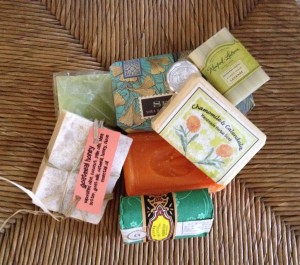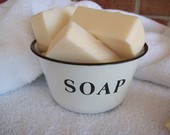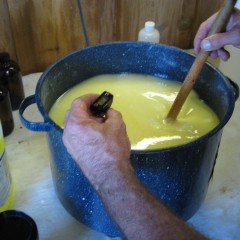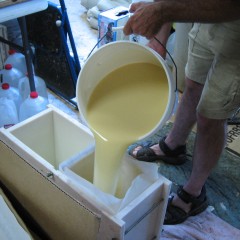Earth Day Ideas for Everyday – Stop using liquid soap in plastic bottles
To celebrate Earth Day everyday, Flying High Solo is republishing this article from the archives on problems, both for the environment and possibly for you, from using liquid facial and bath soaps. Going back to the bar is one of many Earth Day ideas that can help you be earth-friendly everyday.
Liquid soaps in their little plastic bottles may seem convenient. They don’t dribble their suds or coagulate in a soap dish. But they have at least two huge drawbacks. Going back to the bar can solve a couple of big problems.
Problem 1: Plastic Containers
An estimated 577 million plastic containers for liquid soaps entered the environment last year. That’s miles and miles of plastic, 45 thousand miles of plastic bottles, enough to go around the world 1.8 times. * And plastic pollutes.
Bar soaps, on the other hand, have minimal packaging, a simple paper wrap, a string of raffia, and sometimes – they come bare.
Problem 2 – Ingredients
What’s in those little plastic bottles? Maybe something harmful.
An April 2013 article in INC. Magazine on the iconic brand. Dr. Bronner’s Magic Soap quoted David Bronner saying. “There’s nothing more elegant than a properly formulated soap. It’s the most beautiful lather, great skin-feel, great after-feel. You could basically eat our soap.” Not that we recommend that.
“He’s trying to explain the difference between a true soap … and the soaplike detergent products most of us use every day.….. At its most basic, the difference is natural ingredients versus synthetic ones. …. most detergents are made at least in part from nonrenewable petrochemicals (because it’s cheaper that way) and include a chemical cocktail of foaming agents, preservatives, and fragrances that, by and large, have never been tested and found safe for human consumption,” author Tom Foster wrote.
Seems like there’s a lot more to liquid soaps (and some beauty bars) than suds and smell.
What’s in soaps?
Some of the things in liquid and non-natural soaps may be triclosan and triclocarban.
Two Little Blackbirds, a natural soap-maker, says – “These synthetic antimicrobial chemicals kill aquatic life after they go down your drain and into the local water supply, and have been shown to disrupt proper thyroid functioning in humans. Use of triclosan is also associated with the rise of antibiotic-resistant strains of bacteria, producing dangerous infections that don’t respond well to antibiotic medicine. Triclosan or its cousin, triclocarban, can be found on the ingredients labels of soaps, toothpaste, and other personal-care items.”
It not just natural soap makers that report problems with these ingredients. According to Mintel Soap, Bath and Shower Product Report, 2012, “there have been reports that triclosan, an ingredient used in many antibacterial soaps, including liquid hand soap, is potentially dangerous to users and may not provide the efficacy that users think they are getting using an antibacterial product.”
Two Little Blackbirds notes other questionable ingredients and explains their dangers. The cocktail of additives includes “DEA, diethanolamine, cocamide DEA, lauramide DEA, and monoethanolamine, Fragrance, parfum, linalool, limonene. MEA. PEG, polyethylene glycol, polyethylene, polyoxyethylene, oxynol, or words ending in the letters “eth,” such as myreth, oleth, laureth, ceteareth.”
Even “real” soaps differ
In addition to chemicals and preservatives, Foster wrote in INC., “Within the world of real soaps, there are other levels of purity that separate the brands. Most mass-produced soaps are made with animal fats such as tallow (beef fat) or lard (pig or mutton fat). …. Natural soaps are made with nonanimal fats such as olive oil, coconut oil, and palm oil.”
Fortunately, today, there’s a return to natural and/or local, so you can use some simple Earth Day ideas everyday. It’s easy to find soaps made from goat’s milk (my favorite), olive oil, jojoba, aloe, and other natural ingredients. Natural aromas have also proliferated – lemon, lavender, almond, patchouli, orange, rose, and the more masculine Frankincense (yes, I’ve seen it) plus scores more. Some soaps may be made with perfumes, however, so it’s best to read the labels.
Where to find good soap
Check your local health food stores, specialty stores, and even local craft markets. You’ll discover lots of handcrafted soaps made from natural ingredients. To get an overview of the variety, visit The Handcrafted Soapmakers Guild’s gallery of about 100 different specialty soaps. And Real Handmade Soap is another source for finding natural soaps.
Living a good life means attention to all of life’s details – and making each activity – even what may seem like the most trivial – matter. And when it comes to getting clean, living a good life just may mean going back to the bar.
*Author’s note: Here’s how the estimate of plastic waste was derived. In 2011, people spent $1.9 billion dollars on liquid body wash and $788 million on liquid hand soap (Source: Mintel Soap, Bath and Shower Product Report, 2012.)
Estimating $5 each for liquid body wash and $4 each for liquid hand soap, that’s 577 million plastic containers. Next, I estimated the plastic bottles at an average of 5 inches each, that’s 2.8 + billion inches, divided by 12 inches = 240,416,666 feet. I divided that by 5,280 feet to come up with 45,533 miles, enough to go around the world 1.8 times.
Another good thing to do is buy powdered laundry detergent in paper boxes – rather than liquids in plastic bottles – a simple solution that is one of many good-living Earth Day ideas.
By Bojinka Bishop
Photos on soap making courtesy of The Parsonage Handmade Soaps.
See Comments. Click here. Share your ideas and comments. Click here.
Related stories:
- Liquid soap in plastic bottles is horrific for our environmentLiquid soaps in their little plastic bottles may seem convenient. They don’t dribble their suds or coagulate in a soap dish. But they have at least two huge drawbacks. Going back to the bar can solve a couple of big problems....
- Exfoliating beads causing water pollutionUnfortunately, those tiny plastic beads in facial cleansers and other skin products are causing water pollution. They pass right through waste water filters and flow into lakes and oceans – and, because they look like fish eggs, they’re mistaken for food by fish and other wildlife....
- Solo Dinners: Treat YourselfCereal for dinner? No way. You deserve a lovely meal. Cooking for yourself has many advantages. You can 1) eat what you really enjoy, without catering to other’s tastes, 2) save money, it’s cheaper than eating out or buying prepared foods, ...
- Immigrating?A reader asked me to write more about my impending “emigration” from Ohio. I had likened my journey to my grandparents’ trip to America more than 100 years ago and noted some similarities – being a stranger there, having to build a new life. ...
- Family treasures – Solve a mystery in a museumRemember that quirky cup you drank cocoa from in your childhood? You just might find one like it in a museum. Those doorstops, chairs, vases, teapots, lamps, and bowls sitting casually in your parents’ or grandparents’ homes, those mundane everyday objects, just might be valuable. Do-it-yourself “Antiques Roadshow” One way...
FlyingHighSolo.com
Celebrating special people, good ideas, and useful actionsSubscribe
Keep on top of what's new – subscribe to Flying High Solo! You'll get a brief email alerting you to new articles. (Your email is safe -- we will not share it with anyone).
What readers are saying
"amazing variety of topics"
"an intelligent, strong, creative, eclectic approach .... that we don't get a chance to read everyday"
"very cool and intelligent"
Highly Recommended
 Bella DePaulo's blog for Psychology Today, "the truth about singlism..." News, analysis, facts, and stories about being single in America
Bella DePaulo's blog for Psychology Today, "the truth about singlism..." News, analysis, facts, and stories about being single in America









